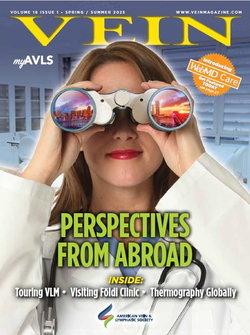“New Horizons” proved to be a fitting theme for the 22nd Annual Congress of the American College of Phlebology which was held November 6-9, 2008 in Marco Island, Florida. With record attendance of more than 900 and the presentation of cutting-edge information and education, the event was indicative of the rapid growth of phlebology and the treatment of venous disease.
As the Director of programs and courses, Dr. Kenneth L. Todd, III, says the educational needs of congress attendees are becoming more diverse with the growth of phlebology. He and the members of the Program Committee attempted to meet that challenge by providing tracks that offered more fundamental information for those who are newer to the practice, along with more advanced and specialized sessions for those who are vein industry veterans.
One very timely and notable symposium at the 2008 congress focused on deep vein thrombosis. DVT, affecting 350,000 to 600,000 Americans annually, is referred to by some as the “undiagnosed epidemic,” with those numbers expected to climb as the population ages. The keynote presentation was given by Dr. Tony Comerota, Director of the Jobst Vascular Center at The Toledo Hospital. Dr. Suresh Vedanthem, Vice Chairman of the Venous Disease Coalition and Associate Professor of Radiology and Surgery at the Washington University School of Medicine, headed the educational symposia. The symposium came on the heels of the U.S. Surgeon General’s call to action on DVT, which aims to raise awareness of the potentially fatal condition, and to educate health care providers on the need for more accurate diagnosis and aggressive treatment of DVT and pulmonary embolism. “Many of our attendees in this session commented on the quality of the presentations by Dr. Vedantham and Dr. Comerota,” said Todd. “Those in attendance truly benefitted from the expertise of these physicians with regard to how we can improve patient care and reduce fatalities associated with DVT.”
Also of note among the educational offerings at the congress was a symposium on aesthetics led by Dr. Neil Sadick, Clinical Professor of Dermatology at Weill Medical College of Cornell University. “This was an area of interest among ACP members,” said Todd. “Many of our practices are experiencing more demand for cosmetic procedures, and the variety of possible treatments continues to expand. Dr. Sadick’s perspective as a board certified dermatologist was valuable to those who are moving in this direction.”
While some important learning and professional development took place on Marco Island, the ACP Annual Congress wasn’t all work and no play. A highly successful silent auction and golf tournament were held to raise funds for the ACP Foundation and its philanthropic endeavors. Todd and members of the planning committee were pleased to see participation in those events reaching unprecedented numbers, as well. The congress also attracted more than 200 industry representatives, showcasing the latest technology and equipment related to the practice of phlebology.
As the planning committee looks forward to the 2009 congress in Palm Desert (November 5-8, 2009), there is a desire to build upon the growth of the event, and to further refine the offerings, both educational and recreational, for those who attend. “We would love to create more opportunities for round-table type discussions that allow for additional Q & A, and sharing of experience and information,” said Todd. “In terms of educational emphasis, we see a need for more information on sub-truncal varicosities in the future, along with further discussion of the increased use of foam sclerotherapy. Those topics, among others, will likely show up on the 2009 educational agenda.” Information on the program, registration and hotel information will be available on the ACP website (www.phlebology.org/meetings/congress.html) in late spring.


